Business Plan PDF

| Title | Business Plan |
|---|---|
| Course | Accountancy Capstone |
| Institution | Queensland University of Technology |
| Pages | 28 |
| File Size | 1.4 MB |
| File Type | |
| Total Downloads | 105 |
| Total Views | 246 |
Summary
Business Plan...
Description
0
Queensland University of Technology QUT Business School School of Accountancy AYB 339 Accountancy Capstone Business Plan Semester 1, 2020
Legal (and Trading) Name: Flavours of Italy ABN: Your group to apply ACN: Your group to apply TFN: Your group to apply PAYG Withholding: Your group to apply Prepared for: Mr Mario Lombardi and Mr Luciano Rossi
To be used throughout the semester
Business Address:
Registered Office:
144 Lancaster Avenue Hendra, QLD, 4011. Phone: (07) 3161 7172 Facsimile: (07) 3161 7174 Postal Address: as above E-mail address: [email protected]
c/- Group Name Level 3, 339 River Parade Brisbane, Qld, 4000. Phone: (07) 3399 3399
________________________________________________________________________________________________________ AYB 339 Accountancy Capstone © Queensland University of Technology
Business Plan Semester 1, 2020
1
1 Executive Summary Flavours of Italy is a new restaurant that will operate in the inner-northern suburb of Hendra. The restaurant will be jointly owned by friends (Mario Lombardi and Luciano Rossi), who have known each other since Grade 5 when they attended school together. The restaurant will be open seven nights per week from 5:00 pm to 11:00 pm. It will also open for lunch from Tuesday to Sunday from 12:00 noon to 3:00 pm. The restaurant will offer authentic Italian meals prepared by two Italian chefs. The dining room will comfortably seat 50 customers. Being a licensed restaurant, the restaurant will not only offer soft drinks and juices, but also a range of alcoholic beverages, such as wines, spirits, beer and champagne. The restaurant will also offer a take-away service for customers who do not wish to dine in. The take-away prices will be approximately 10% to 20% cheaper than the dine-in prices. A home delivery option will also exist, whereby customers can dial the restaurant and place an order for home delivery. Once again, the delivery prices will be approximately 10% to 20% cheaper than the dine-in prices. In the next few months, a website will be developed which will allow customers to place their orders online directly with the restaurant. In all, the restaurant will employ a total of six staff (including Mario and Luciano), including a full-time chef, a casual waiter and waitress to assist in serving customers and a casual delivery driver. Given the demographics of the residents in Hendra, with the median weekly household income being $2,274 and more than 86% of the residents being couples with and without children, the restaurant aims to offer Italian food at the medium-top end of the market. The restaurant will be contemporary but at the same time offer authentic Italian food to customers. Whilst there are several other Italian restaurants in surrounding suburbs such as Ascot, Clayfield, Albion and Hamilton, there are no Italian restaurants specifically located in Hendra itself. The next closest Italian restaurant, Viale Canova Italian Restaurant, is located in Clayfield with Fiamme Trattoria, located in Albion. As such, this provides a unique opportunity. The business will be structured as a unit trust ("The Flavours of Italy Unit Trust"). Mario and Luciano's discretionary family trusts (which are already in existence) will be the two unitholders, holding 50% each of the units in the unit trust (each unit being $1.00 each). The trustee will be a company, Flavours of Italy Pty Ltd. Mario and Luciano will be the two directors of the corporate trustee and the two equal shareholders. As the legal name of the company (being Flavours of Italy Pty Ltd) is the same as the trading name of the business, there is no need to register the business name. Professional market researchers are currently undertaking a full marketing plan. Other key information pertaining to the business is outlined below:
The opening date of the restaurant is planned to be 1 August 2018. An opening party is planned the night before the opening of the restaurant (ie. 31 July 2018) with invitations being sent to local store owners, suppliers and selected residents and their families. The restaurant is expecting a pre-tax net profit of approximately $45,940 after the first 11 months of trading (ie. by 30 June 2019). The restaurant aims to make a pre-tax net profit of approximately $69,300 by 30 June 2020 and $107,600 by 30 June 2021.
________________________________________________________________________________________________________ AYB 339 Accountancy Capstone © Queensland University of Technology
Business Plan Semester 1, 2020
2
2 Business Profile 2.1
The Business Concept The business concept is to open an authentic Italian and Pizza restaurant in Hendra. The restaurant will not only offer a complete dine in experience, but will also offer customers the choice of take-away and home delivery.
2.2
Market Analysis and Outlook The most recent set of ABS statistics providing a snapshot of people living in Hendra (postcode of 4011) published in 2016 can be downloaded at: https://quickstats.censusdata.abs.gov.au/census_services/getproduct/census/2016/qu ickstat/SSC31332?opendocument According to the census data, there were a total of 4,625 people living in the inner northern suburb of Hendra in Brisbane. The median weekly household income is $2,274. For couple families with two incomes, the median income for those with children was $2,727. Apart from English, the next most commonly spoken language is Italian followed by Mandarin and French. Professionals make up the largest occupation, accounting for 28% of all workers in Hendra. Interestingly, of all the employed people in Hendra, the sector with the third largest number of people employed was in the "restaurants and takeaway food services" industry. In Hendra, couples with children accounted for 49.5% of the population, whilst couples without children accounted for 35.9% of the population.
Figure 1: Map of Hendra
________________________________________________________________________________________________________ AYB 339 Accountancy Capstone © Queensland University of Technology
Business Plan Semester 1, 2020
3 2.3
2.3 Primary Target Markets
Given the demographics in Hendra, the market can be segmented into three distinct primary target markets:
individuals (including couples without children) that prefer to have a dine-in experience at a local restaurant typically after work. This incorporates young upper professionals who work closeby. sophisticated families (with children) that are looking for good quality food at affordable prices; and take-away and home delivery markets for those consumers who do not have the time to dine in at restaurants and who want to stay at home, and have food delivered to them.
Diners at Italian restaurants are usually between the ages of 25 and 55, and with disposable incomes above $60,000. These demographics will help us develop marketing strategies and tailor our food, services and prices to suit these demographics.
2.4
Competition There are several Italian restaurants in surrounding suburbs, including Ascot, Clayfield, Albion and Hamilton. These include Italian restaurants such as Viale Canova Restaurant, Dolci Sapori and La Cena Mediterranean (all located on Sandgate Road), Monza Restaurant on Alexandra Road and Sophia's Gourmet on Junction Road. Despite this, there are no Italian restaurants in Hendra itself.
2.5
Statistics Relating to the Restaurant Industry in Australia IBISWorld (October 2019) reported the following statistics involving the Australian restaurant industry:
In the 2018/19 year, the restaurant industry in Australia generated revenue of approximately $19 billion; The total profits generated by this industry in 2018/19 was approximately $342 million (or 1.8% of total revenue). The number of restaurants in Australia at 30 June 2019 was 23,141; In 2018/19, these businesses employed a total of 180,269 people. On average, restaurants employ 7.79 employees; The restaurant industry has experienced growth of 0.6% over the past five years (from 2015 to 2020) and is expected to grow 0.2% over the next five years to 2025; Over the 10 years through 2029-30, the industry’s contribution to the economy is expected to rise by an annualised 0.3%. This represents an underperformance relative to the economy, with GDP forecast to grow by an annualised 2.6% over the same period. The industry's relatively slower growth is typical of a mature
4
2.6
Number of Establishments and Concentration of Restaurants As mentioned above, the total number of restaurants in Australia at 30 June 2019 was 23,141. As the pie chart below indicates, Queensland accounts for 18.1% of all restaurant establishments in Australia.
________________________________________________________________________________________________________ AYB 339 Accountancy Capstone © Queensland University of Technology
Business Plan Semester 1, 2020
5 The geographic spread of the industry is closely correlated with population and income distribution, and general economic activity. Restaurants tend to be located in densely populated areas where they have greater exposure to consumer traffic. New South Wales, Victoria and Queensland have more than three quarters of the population, and consequently, account for an estimated 81.4% of industry establishments. The number of industry establishments in Queensland has risen over the past five years. The higher number of restaurants located in Queensland reflects increased tourism and the continued migration of individuals towards the northern states of Australia. The restaurants industry has low market share concentration, with no player accounting for more than 5% of revenue in 2019-20. The industry is highly fragmented and dominated by small, individual businesses. The industry is comprised mainly of small businesses and most employ fewer than 20 people. Barriers to entry are low and therefore do not significantly inhibit new players. The low level of industry concentration has resulted in fierce competition among operators. Restaurants typically compete based on price, menu offerings and customer service. Owner-operators typically invest a significant proportion of their own time and effort into running their restaurants. This discourages widespread expansion as owners may not be able to effectively manage multiple locations. Interestingly, at 30 June 2019, there were 4,627 pizza restaurants in Australia. Industry revenue is forecast to increase by an annualised 1.2% over the five years through 2023-24, to be worth $3.6 billion. This trend includes anticipated growth of 0.9% in the current year. 2.7
Markets and Products The restaurants industry can be segmented into three main groups.
The first is the high-end silver service or premium dining segment (25%), which offers high levels of service, luxury settings and quality food and ingredients. Wellknown or celebrity chefs often prepare the food and menu, with the high prices also reflecting the ambience and overall dining experience. The premium restaurant segment accounts for the smallest share of industry establishments. However, this segment generates significantly more revenue than its share of establishments would indicate. Over the past five years, customers have been increasingly choosing cheaper restaurants and reducing or avoiding entrees and desserts. As a result, this segment has declined as a share of industry revenue over the period. Patrons have also curbed spending on extras such as pre-dinner drinks and mealtime beverages. Entrees, desserts and coffees tend to be the higher profit margin products for restaurants. Discretionary income is projected to increase over the next five years. As a result, this segment is projected to earn a greater proportion of its revenue from non-food offerings such as beverages.
The second is the middle-range dining segment (52%), which typically offers good-quality food, moderate prices and a small range of takeaway food options.
________________________________________________________________________________________________________ AYB 339 Accountancy Capstone © Queensland University of Technology
Business Plan Semester 1, 2020
6 The mid-range segment accounts for the second largest share of total establishments. However, this segment accounts for the largest share of industry revenue, due to its focus on higher quality and more expensive meals. The midrange segment offers a wide variety of food styles and maintains the broadest appeal across all consumer groups. This segment has grown as a share of industry revenue over the past five years, as consumers have sought a middle ground between premium and low-cost restaurants. This segment has also benefited from a more prominent food culture, with fashionable new restaurants often falling into this category. The use of social media, such as Instagram, has bolstered revenue growth in this segment, as it has allowed fashionable establishments to attract new customers and build their brand. In addition, the increasing popularity of home delivery services, such as Uber Eats, has allowed mid-range dining to increase its share of revenue from takeaway options, supporting growth in this segment. This segment's growth is projected to continue over the next five years as consumers will likely focus on trendy restaurants instead of traditional premium establishments.
The third is the low-cost dining segment (23%), which relies on quick service, high table turnover, low-price menus and a limited range of food and specialties. Restaurants in this segment generate higher takeaway revenue. This segment accounts for the largest share of industry establishments. However, this segment generates less revenue than its share of establishments would indicate. Low-cost restaurants typically offer simple value-based meals with few extras. Low-cost restaurants have lower operational costs and a higher component of basic takeaway revenue. Higher operational flexibility, cheaper meals and low fixed costs have boosted this segment's share of industry revenue over the past five years. Lower menu prices mean these businesses are less vulnerable during periods of declining household discretionary spending. Continued demand from inner-city workers has also aided this segment, as these patrons tend to consume costefficient meals during lunch and dinner. The rising popularity of food delivery services such as Uber Eats has also boosted takeaway revenue for low-cost dining, supporting this segment's growth.
________________________________________________________________________________________________________ AYB 339 Accountancy Capstone © Queensland University of Technology
Business Plan Semester 1, 2020
7 A breakdown of the three main market segments is shown in the pie chart below.
2.8
Competition The Restaurants industry has low market share concentration, with no player accounting for more than 5% of revenue in 2019-20. The industry is highly fragmented and dominated by small, individual businesses. The restaurants industry faces a high level of competition. Industry participants compete based on price, quality, menu offering and cuisine, marketing, location, customer service and reputation. The industry is also subject to external competition from cafes, coffee shops, fast-food operators, pubs, taverns and clubs. Cafes and coffee shops have increasingly adapted to suit the fast-paced lifestyle of time-conscious inner-city dwellers, with demand for on-the-go coffee and made-toorder meals growing. This has chipped away at the revenue of many inner-city restaurants that cater to a market looking to sit down and enjoy a full-service meal. Fast food operators have also expanded their range of options, provide restaurant quality meals to quality-conscious consumers.
________________________________________________________________________________________________________ AYB 339 Accountancy Capstone © Queensland University of Technology
Business Plan Semester 1, 2020
8 Restaurants also compete on the basis of location, style, ambience, hospitality and service. More than ever, restaurants are selling and marketing a meal experience to potential customers. In terms of pizza restaurants, competition from healthier fast food products and innovation in frozen supermarket goods represent ongoing threats to industry revenue growth. Intense competition among industry operators has also constrained revenue growth, forcing traditional pizza shops to compete on price. While this trend has negatively affected industry profit margins, the rising prominence of gourmet pizzas, which attract higher prices, has offset this trend.
________________________________________________________________________________________________________ AYB 339 Accountancy Capstone © Queensland University of Technology
Business Plan Semester 1, 2020
9 Industry competition is anticipated to intensify over the next five years. As industry establishment numbers grow, operators will be forced to fight for market share by offering higher quality products at lower prices. Competition will also drive franchises to develop new menu items faster. Historically, product variety has not been a point of competition. However, this trend has changed over the past five years, as evidenced by the success of Crust Gourmet Pizza Bar. As evidenced in the chart below, the pizza industry is dominated by Domino's Pizza, which has a network of over 2,450 Domino's Pizza stores, including 830 in Australia and New Zealand, as of March 2019. The company's store numbers have grown rapidly over the past five years
2.9
Industry Life Cycle The restaurants industry is in the mature stage of its life cycle. Industry value added, a measure of the industry's contribution to the overall economy, is expected to rise by an annualised 0.3% over the 10 years through 2024-25. This represents an underperformance relative to the economy, with GDP forecast to grow by an annualised 2.6% over the same period. The industry's relatively slower growth is typical of a mature industry. The number of industry establishments is anticipated to expand strongly over the 10 years through 2024-25. Strong demand for quality food and dining experiences has encouraged firms to enter the industry over the past five years. However, restaurants compete fiercely for prime locations and customer numbers, and failure to offer a successful price or quality proposition can lead to industry exits.
________________________________________________________________________________________________________ AYB 339 Accountancy Capstone © Queensland University of Technology
Business Plan Semester 1, 2020
10 Additionally, the industry's fragmented and saturated nature makes it difficult for players to gain significant market share. However, there are still growth opportunities in the market due to changing lifestyle trends and greater public concern over health and nutrition. Demand is shifting away from high-fat, deep-fried, super-sized meals towards healthier meal options as concern grows over rising obesity and diabetes levels. 2.10
Major Markets and Consumer Segmentation The discretionary nature of industry services means that markets with higher incomes are more lucrative for the industry. As a result, the major markets for the industry can be segmented in terms of household income quintiles.
As can be seen from the pie chart above, the Highest Income Quintile accounts for the largest share of restaurant industry revenue. Households earning the highest amount of income per week have a larger amount of income to spend at re...
Similar Free PDFs

CUE- Business-PLAN - Business plan
- 10 Pages

Business-Plan - Business plan Enc
- 48 Pages
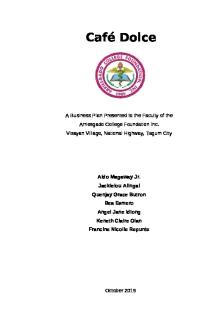
Business Plan
- 26 Pages

Business PLAN
- 3 Pages
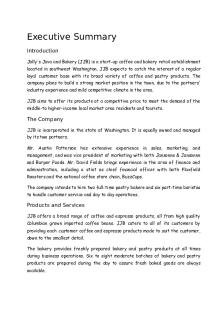
Business PLAN
- 21 Pages
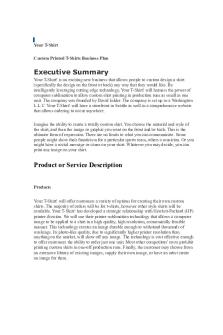
Business PLAN
- 10 Pages

BUSINESS PLAN
- 24 Pages
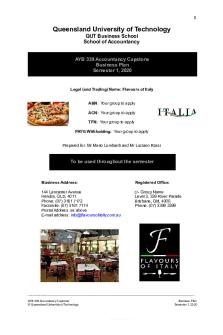
Business Plan
- 28 Pages

Business Plan
- 21 Pages
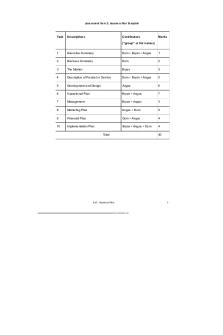
Business plan
- 40 Pages

Business Plan
- 47 Pages

Business Plan
- 10 Pages

Business Plan: Lip Balm Business
- 35 Pages
Popular Institutions
- Tinajero National High School - Annex
- Politeknik Caltex Riau
- Yokohama City University
- SGT University
- University of Al-Qadisiyah
- Divine Word College of Vigan
- Techniek College Rotterdam
- Universidade de Santiago
- Universiti Teknologi MARA Cawangan Johor Kampus Pasir Gudang
- Poltekkes Kemenkes Yogyakarta
- Baguio City National High School
- Colegio san marcos
- preparatoria uno
- Centro de Bachillerato Tecnológico Industrial y de Servicios No. 107
- Dalian Maritime University
- Quang Trung Secondary School
- Colegio Tecnológico en Informática
- Corporación Regional de Educación Superior
- Grupo CEDVA
- Dar Al Uloom University
- Centro de Estudios Preuniversitarios de la Universidad Nacional de Ingeniería
- 上智大学
- Aakash International School, Nuna Majara
- San Felipe Neri Catholic School
- Kang Chiao International School - New Taipei City
- Misamis Occidental National High School
- Institución Educativa Escuela Normal Juan Ladrilleros
- Kolehiyo ng Pantukan
- Batanes State College
- Instituto Continental
- Sekolah Menengah Kejuruan Kesehatan Kaltara (Tarakan)
- Colegio de La Inmaculada Concepcion - Cebu


